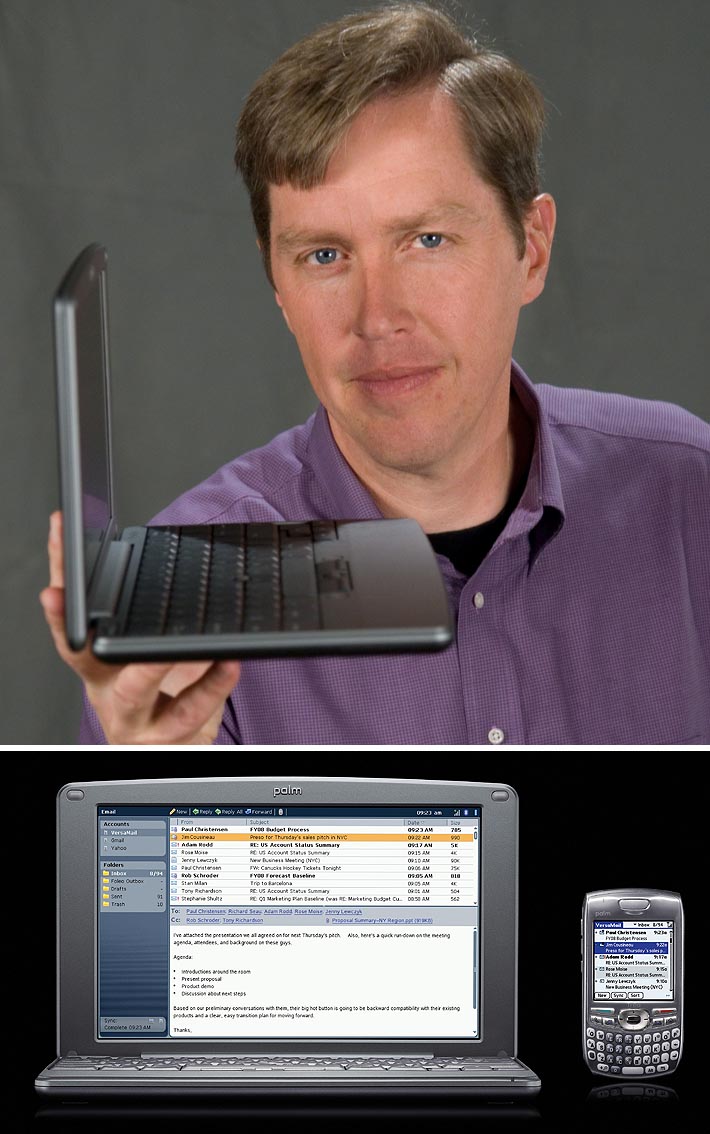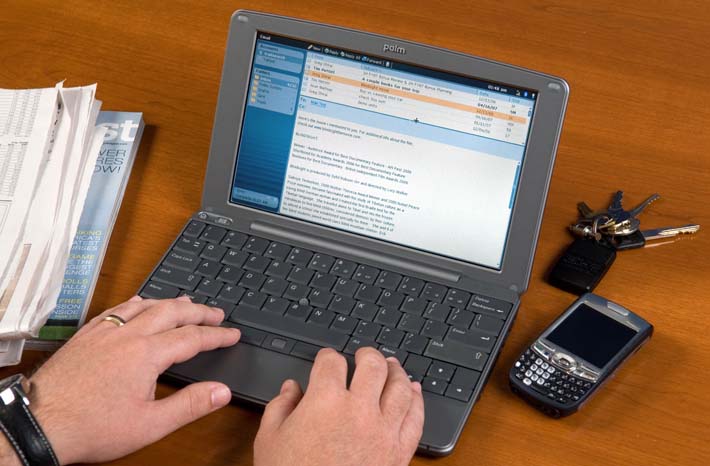

Current Cover
|
|
|
|
Palm FoleoLarge-screen Linux-based mobile companion to smartphonesby Conrad H. Blickenstorfer
On May 30, 2007, none other than Jeff Hawkins himself introduced what the pen computing pioneer, inventor of Graffiti, inventor of the Palm Pilot, founder of Handspring and creator of the Treo considers one of the most important mobile computing products ever -- the Palm Foleo. What is the Palm Foleo? That requires some explanation from Jeff Hawkins himself, the man who always sees things clearer and seems one of the few who truly thinks things through.
See, Hawkins created the original Palm Pilot because regular PCs were too big and complicated and you really didn't need to shlep a big old notebook around just to get access to your contacts and appointments. But since tiny real computers weren't possible back in the mid 1990s, they invented the Palm Pilot. It wasn't a computer, just an organizer, one that very easily connected and synchronized with computers.
Time doesn't stand still, of course, and the Palm eventually did become a little computer. Then Hawkins conceived the smartphone and the first Treo, and now you had a little computer that could even connect to the internet and browse the web. It could do it all. Except doing it all on a tiny screen and a tiny keyboard just isn't fun, and it just doesn't make sense. And Jeff Hawkins is big on common sense.
What is needed, Hawkins reasoned, is something with a large display you can actually see, and with a full-size keyboard so you can actually type the way most people type on a standard keyboard. So he thought up a companion to the smartphone. The concept had actually been in his mind for several years, pretty much since the first Treos, but the market wasn't quite ready. Now it is. And so Palm released the Foleo.
Many who see the Foleo for the first time will think, "Hmmm... so now Palm is doing a little laptop? That makes no sense." But it does. The Foleo is not a laptop replacement. It's simply a mobile companion for all those people who do a lot of wireless email. So instead of squinting at a tiny smartphone screen and then struggling to do real work on a tiny thumbtype keyboard, the Foleo gives them a neat 10-inch display with 1024 x 600 resolution and a full-size keyboard. Yes, full-size, even though the Foleo is actually very small. It measures 10.6 x 6.7 inches and is less than an inch thick. That's barely larger than the QWERTY part of a full-size keyboard. Jeff Hawkins is proud of that. "It's probably the smallest device with a full-size keyboard ever." It has great industrial design, too. Very simple, very pleasing.
But there's more. Hawkins always liked things simple. No long boot process. No complex windows. No perplexing user interfaces. And long battery life. The Foleo fits the bill. You never have to boot it. It is "instant on" in the truest sense of the word. In fact, it's always on. You never turn it off. It doesn't use any sort of windowing sceme. An application takes up the whole screen and is optimized for it. You switch between applications with an "app" button.
How does it do it? Well, it's based on Linux. And it uses Flash instead of a hard disk. It runs five hours easy on a charge, so there is no mad scramble to find an outlet in a meeting room or in an ariport. You just do what you do with a smartphone. Use it all day, then charge it during the night. It has a USB port, video out (1024 x 768), a SD Card slot and another internal CF Card slot. There is no touchscreen because it is not needed. There is also no mouse. Instead, you use a little scroll wheel sitting centerspace below the keyboard.
"Pairing" it with a Treo is a simple 4-step process. But don't think the Foleo is just for Treos. Hawkins sees no reason why the Foleo should not also support Blackberrys and Symbian devices. It's all open source an can easily be done.
Just like the Palm Pilot started out as a simple organizer and then evolved into something more, the Foleo is starting out as a simple smartphone companion with email as its main application. So for now it syncs email, contacts, attachments. You can edit Word, Excel and Powerpoint files, and there is a PDF viewer. For Palm-based Treos they support VersaMail, for Windows Mobile devices it's Pocket Outlook. They also wrote a cool Photo browser. And the Foleo uses Opera to browse the web via WiFi, Bluetooth or the companion smartphone.
Eventually, Hawkins says, the Foleo may become more of a laptop. It's a simple Linux machine, so writing applications for it is easy. It already has a terminal application.
What does it all cost and when will it be available? The plan is to sell the Foleo for USS$499, after a US$100 rebate, and make it available sometime this summer.
Palm Announces Release of Foleoby Tim HillebrandIn a Webcast today, Jeff Hawkins, the founder of Palm, introduced the new Foleo. What's a Foleo? It's not a laptop; it's not a Tablet; it's not a UMPC; it's not a smartphone. You might think of it as a smartphone enhancing docking station. It was originally intended to hook up to a mobile phone for a better email reading experience for mobile email junkies. There are two problems with PDAs: small screen and lack of keyboard. The Foleo solves both of these issues by offering a full size keyboard and a 10-inch display. It is highly portable with a sleek design and weighs only 2.5 pounds. With a long battery life of over five hours, it promises more independence from being tethered to an electrical outlet. It runs on a Linux-based operating system and offers Wi-Fi and Bluetooth connectivity so that you can get online almost anywhere. It will hook up to almost any mobile phone, but is currently primarily oriented to Palm and Windows Mobile devices. It comes with a special Opera Web browser and there is third party software available for viewing, editing, and creating Microsoft Office documents. Basically, anything you can view on the Foleo that you can view on your handheld device. It works with Outlook--sort of--it only syncs email and contacts, but no appointments, which is weird and of limited value. Palm extended an invitation to software developers and hopes to have lots of applications available soon. It doesn't have a touch screen, but Palm has made it easy to navigate with a scroll wheel and offers many other nice features such as one touch email button. A touch of a button turns the device on and off instantly. There is no booting up the system because it uses flash memory. When you turn it on, it comes up with the same content displayed as when you turned it off. The Foleo has two expansion slots, one for a CF card, and one for an SD card. I'm not certain how many USB ports it has, but I hope a few. Apparently the underpowered processor it not great for displaying videos and playing games, but Palm expects to improve this in future releases. This mobile phone partner does not have sizeable windows. The 1024 x 600 resolution screen is not touch sensitive, but seems adequate for PowerPoint projections. You may be surprised at the price, which is only $499. This is the level Microsoft expected for UMPCs, which did not happen. But then, the Foleo is not as powerful nor as sophisticated as a laptop or a UMPC. The question is, where will it fit in the mobile paradigm and will it have lasting value? The Foleo will be released in the United States first and will start shipping sometime this summer.
|

